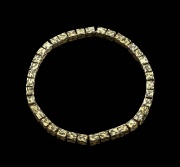Difference between revisions of "Tombac"
Jump to navigation
Jump to search
(username removed) |
m (Text replace - "== Authority ==" to "== Sources Checked for Data in Record ==") |
||
| Line 8: | Line 8: | ||
tambac; tombak; white copper; white tombac; tambaycke; Tombak (Deut.); tombac (Ned.); | tambac; tombak; white copper; white tombac; tambaycke; Tombak (Deut.); tombac (Ned.); | ||
| − | == | + | == Sources Checked for Data in Record == |
* G.S.Brady, ''Materials Handbook'', McGraw-Hill Book Co., New York, 1971 Comment: p. 657 | * G.S.Brady, ''Materials Handbook'', McGraw-Hill Book Co., New York, 1971 Comment: p. 657 | ||
Revision as of 21:21, 1 May 2016
Description
Any bronze alloy used to imitate gold. Tombac is composed of copper (70-92%) and zinc (8-30%). Some arsenic is added to give depth and shine to the alloy. Tombac is used for inexpensive jewelry and buttons. Other alloys that imitated gold, such as Mannheim gold and Dutch metal were also called tombac.
Synonyms and Related Terms
tambac; tombak; white copper; white tombac; tambaycke; Tombak (Deut.); tombac (Ned.);
Sources Checked for Data in Record
- G.S.Brady, Materials Handbook, McGraw-Hill Book Co., New York, 1971 Comment: p. 657
- Susan E. Schur, Conservation Terminology: A review of Past & Current Nomenclature of Materials, Technology and Conservation, Spring (p.34-39); Summer (p.35-38); Fall (p.25-36), 1985
- Dictionary of Building Preservation, Ward Bucher, ed., John Wiley & Sons, Inc., New York City, 1996
- Random House, Webster's Encyclopedic Unabridged Dictionary of the English Language, Grammercy Book, New York, 1997
- The American Heritage Dictionary or Encarta, via Microsoft Bookshelf 98, Microsoft Corp., 1998
